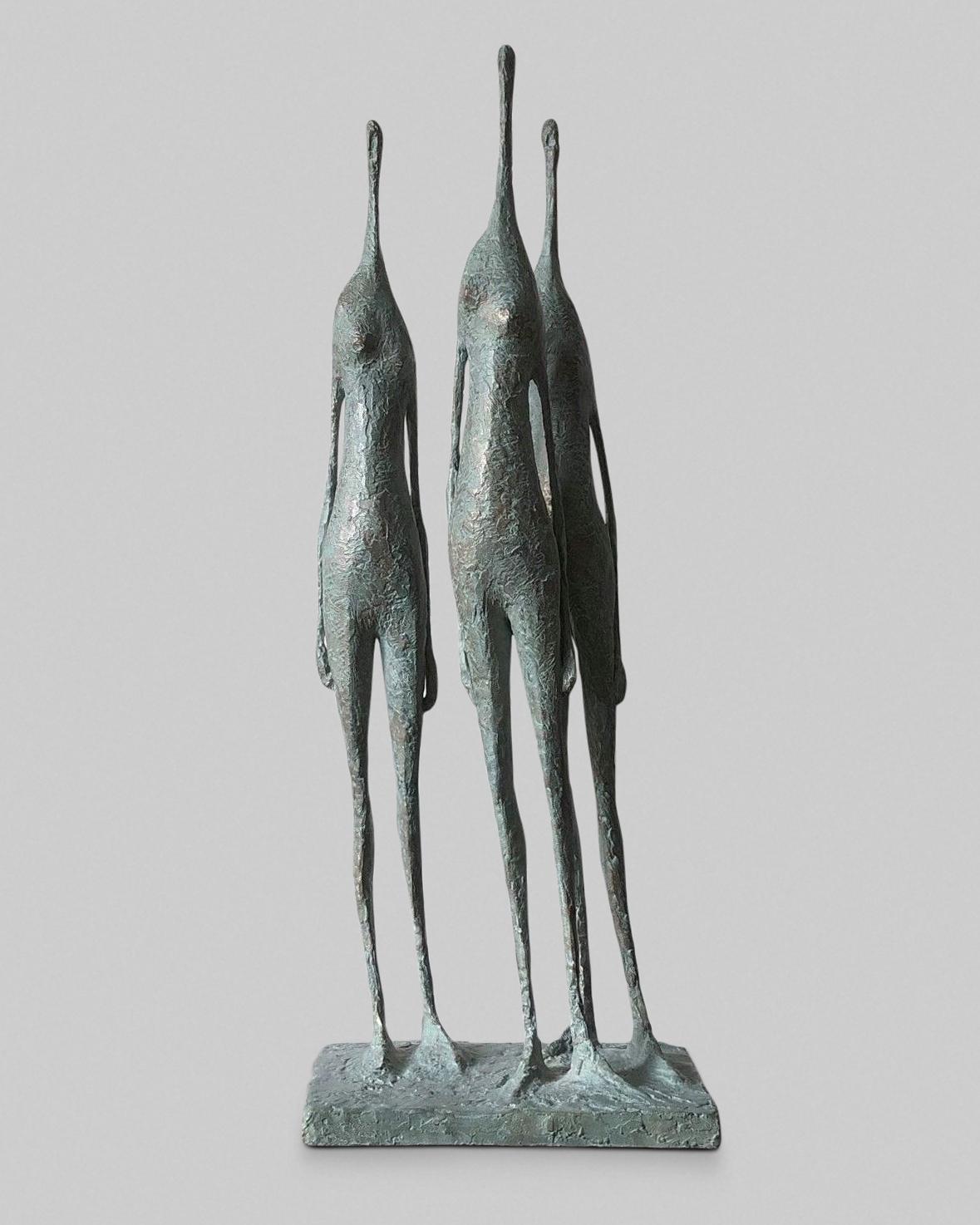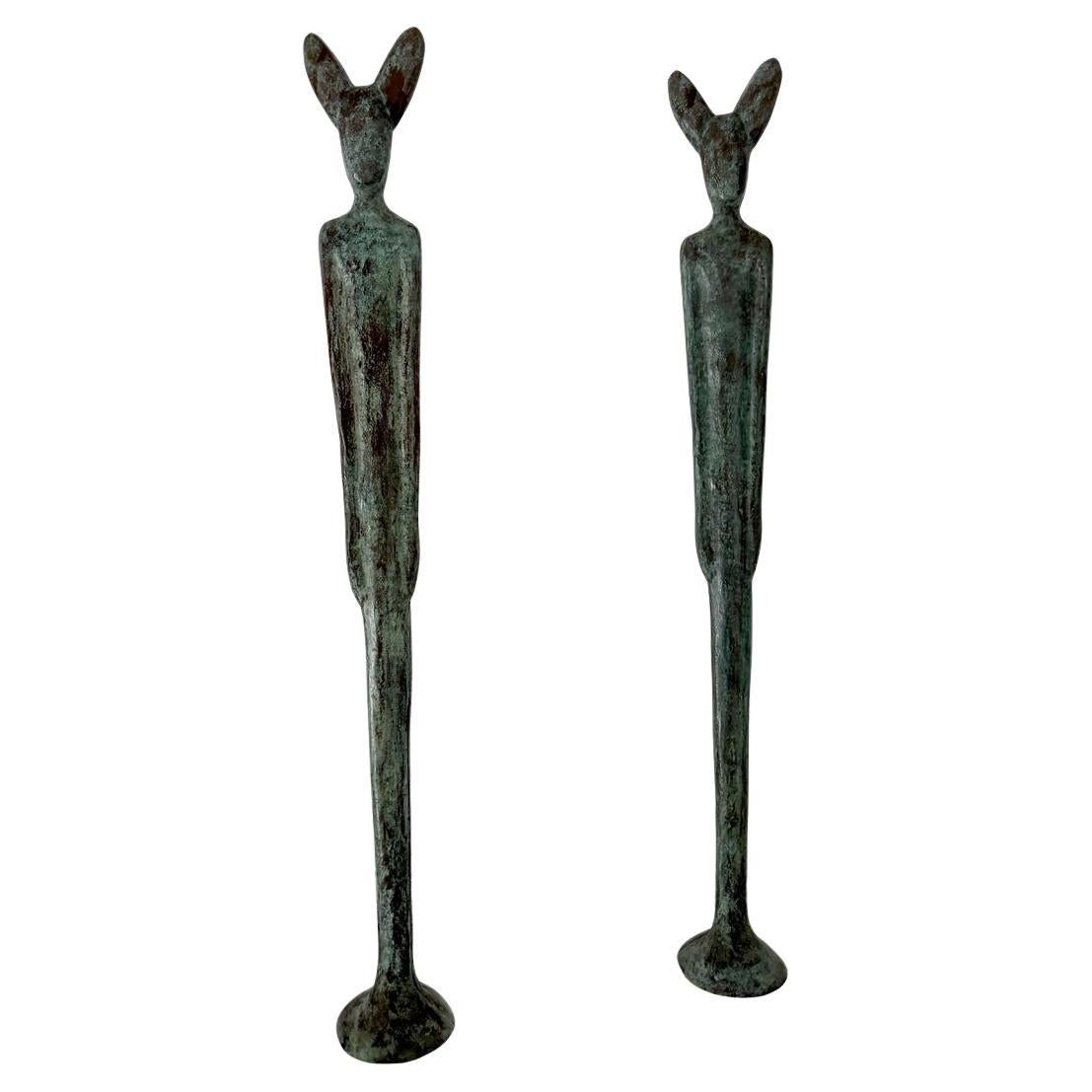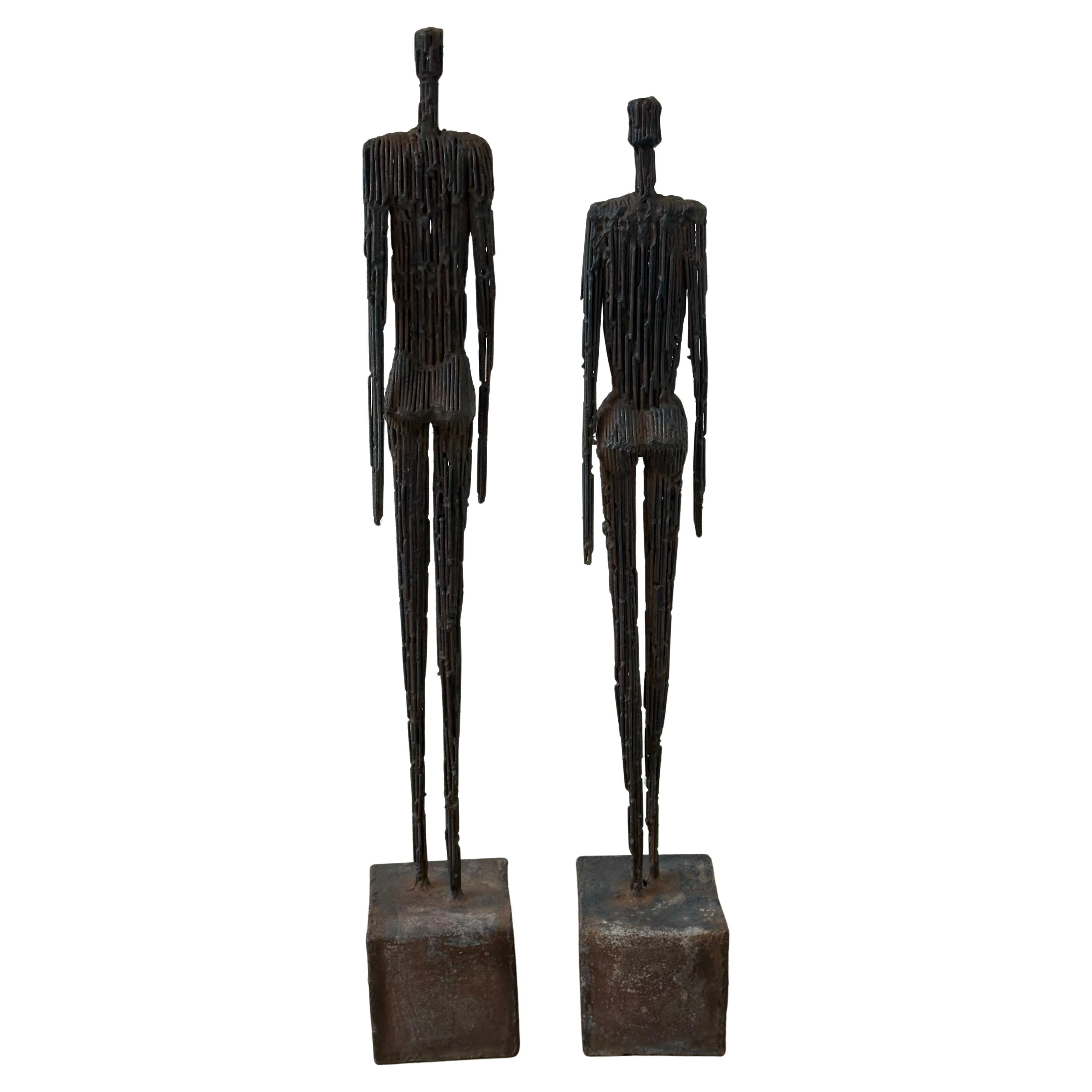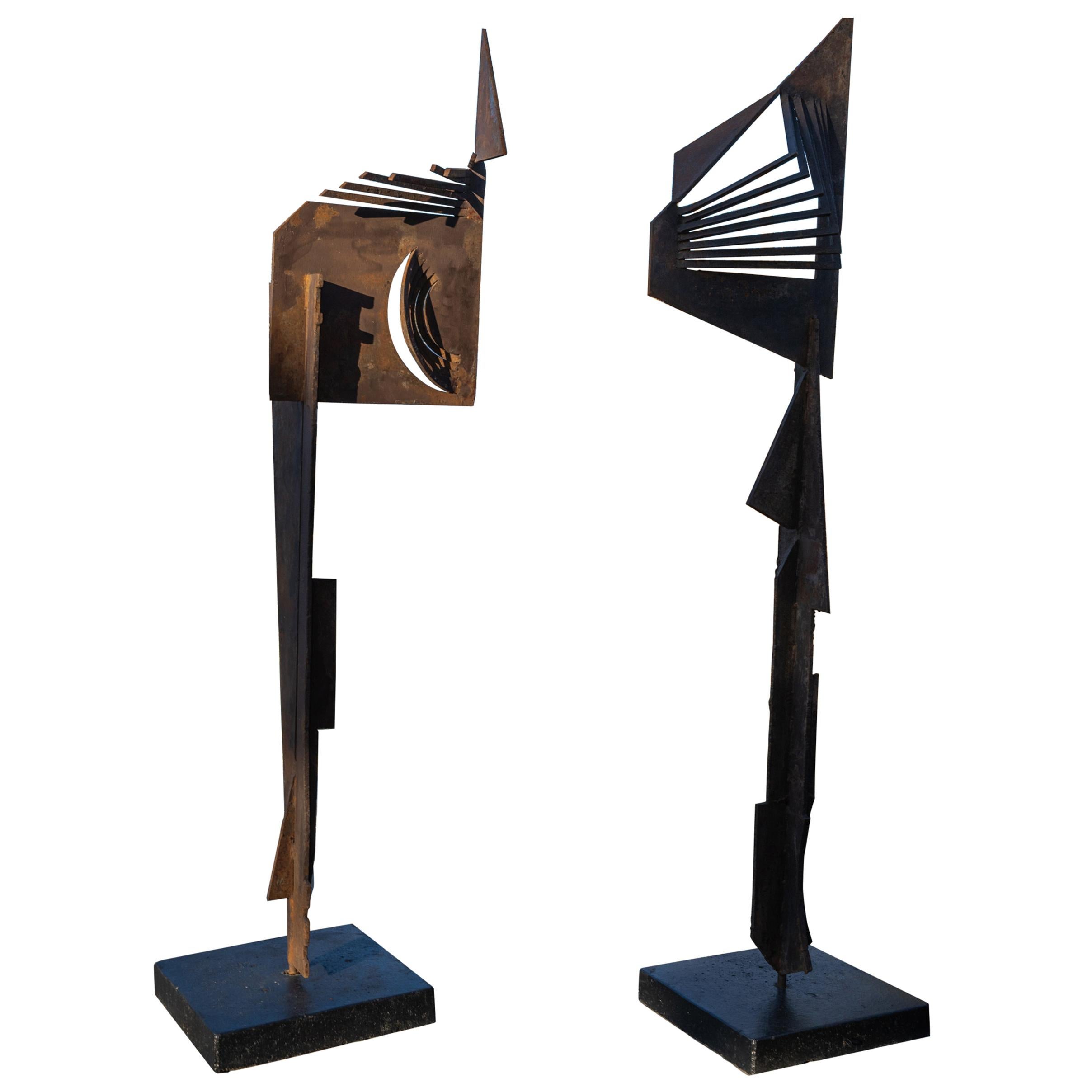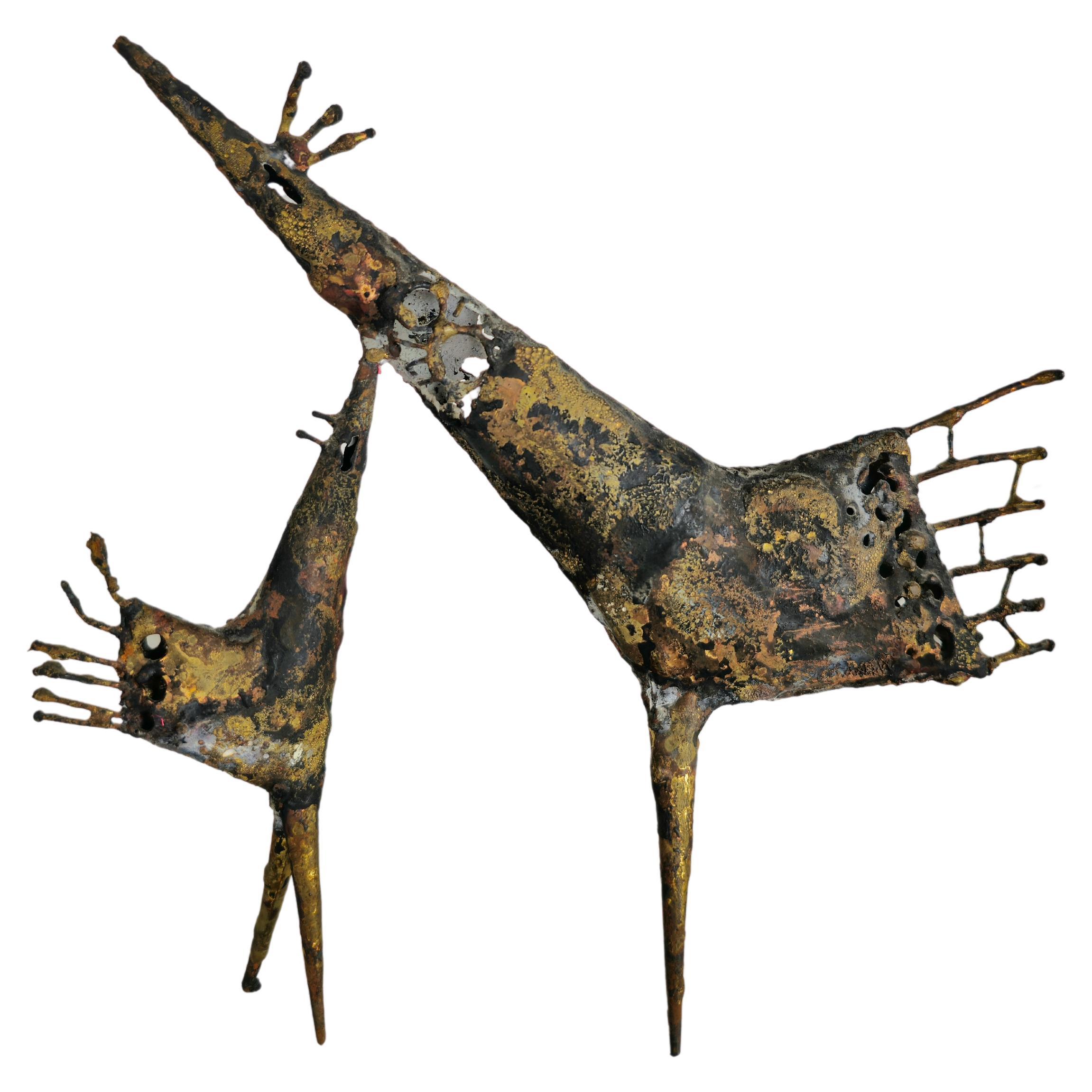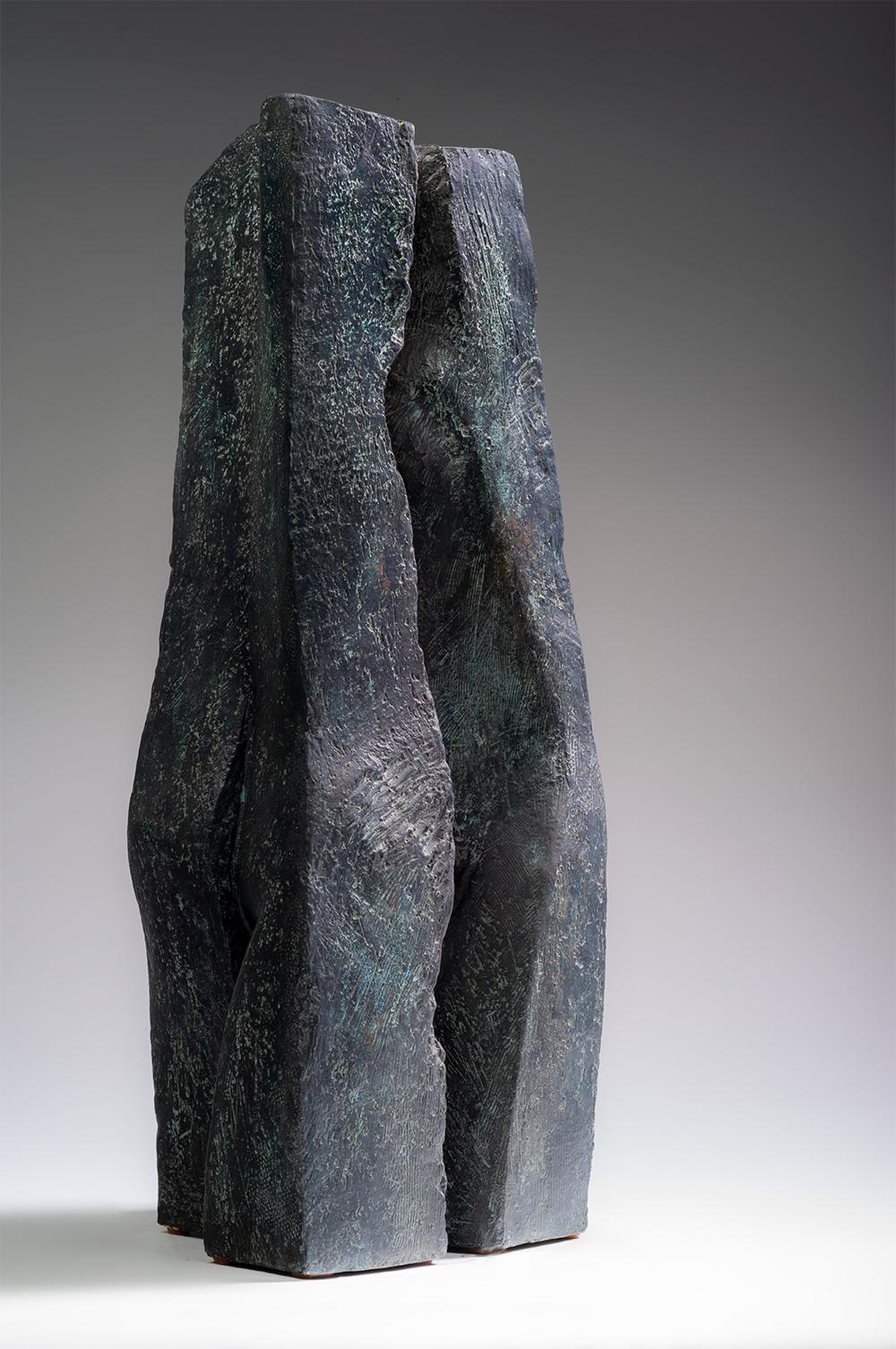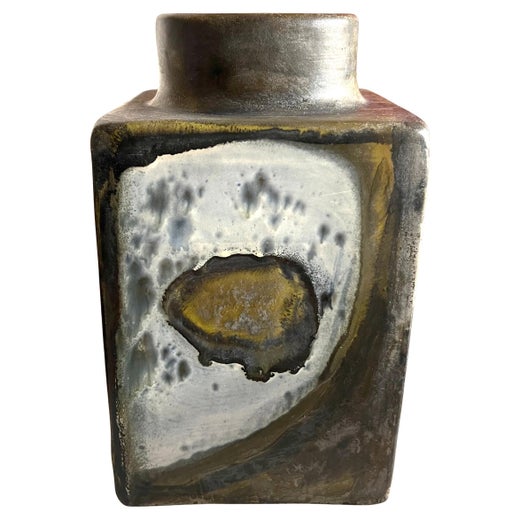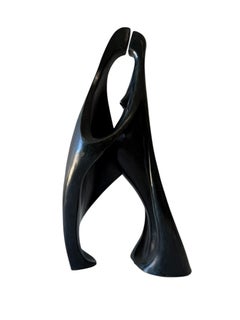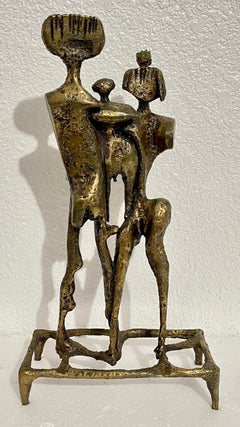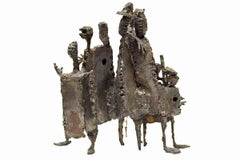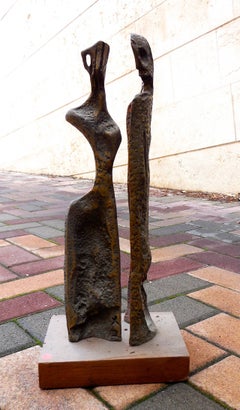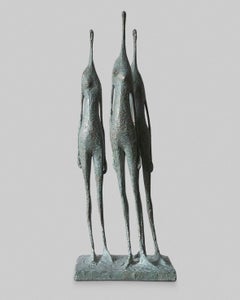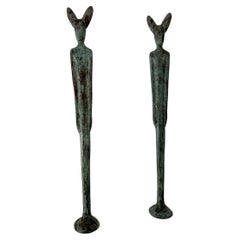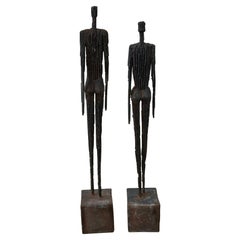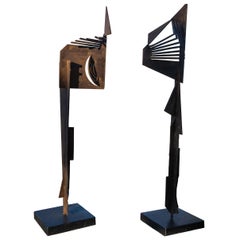Items Similar to Marcello Fantoni Firenze Raymor Pair Figures Welded Brutalist Italian Sculpture
Want more images or videos?
Request additional images or videos from the seller
1 of 7
Marcello FantoniMarcello Fantoni Firenze Raymor Pair Figures Welded Brutalist Italian Sculpturec.1950-1970
c.1950-1970
$2,200
£1,670.51
€1,910.36
CA$3,073.72
A$3,418.65
CHF 1,785.11
MX$41,601.29
NOK 22,798.59
SEK 21,381.06
DKK 14,257.71
Shipping
Retrieving quote...The 1stDibs Promise:
Authenticity Guarantee,
Money-Back Guarantee,
24-Hour Cancellation
About the Item
Marcello Fantoni brutalist welded torch cut metal figurines. Signed on base. Metal label reads "Fantoni Firenze Italy Raymor".
Italian Mid century modern Sculptural pair of students.
Marcello Fantoni (1915-2011) sculptor, ceramicist, metalworker, multimedia artist and designer
Born in Florence in 1915, Marcello Fantoni began studying ceramic art at age 12 at the Art Institute of Florence with ceramicist Carlo Guerrini, artistic director of the famed Cantagalli Factory. He continued years of training in ceramics and the arts, including sculpture with Libero Andreotti and Bruno Innocenti, and figurative art with Gianni Vagnetti, graduating as a maestro of art in 1934. After a stint as art director for a ceramics factory in Perugia, in 1936 he opened the Fantoni Ceramic Studio in Florence. Here he produced ceramic series as well as unique mod pieces, sculptures and furnishings. In 1937 Fantoni’s pieces were exhibited in the Florence National Arts and Crafts Exhibit where their unique combination of rustic forms decorated with African and marine motifs and painted figures garnered considerable acclaim. By the start of World War II Fantoni’s melding of ancient Italian pottery techniques with decidedly Modernist elements had won him artistic and commercial success both in Italy and abroad.
Having participated in the resistance, after the War Fantoni worked for the 500-year old Maiolica factory in Deruta, Umbria, renowned for its signature tin-glazed pottery. In the 1950s he refocused on his Florence studio, dedicating himself to larger sculptural pieces and working on many collaborations. He also expanded his experimenting with materials, forms, drawing from varied influences – Primitivism, Novecento style, Cubism and Abstract Expressionism. Fantoni gave special emphasis to ancient Etruscan ceramic techniques, glazes and colors, heightening the timeless appeal of his pieces. As well as clay, he also worked in metals to great effect. Whether created as a series or as a unique piece, every Fantoni piece was ultimately rendered unique by his hand-painting it. The extraordinary diversity of shapes and textures notwithstanding, one the most identifiable qualities of his creations was his painting style. Through the 50s and 60s he made many cubist-inspired vases and ewers painted in colors bordered by sgraffito lines scratched through the paint in a manner evoking Picasso and Braque. Along with figurative and abstract works, the 60s also saw Fantoni creating brutalist pieces with edgy, angular shapes, while in later life, his work took a minimalist turn.
In 1970 Fantoni founded the International School of Ceramic Art, dedicated to teaching ceramic arts and experimentation. (Many of his students and employees would go on to become noteworthy artisans and artists in their own right.) Maintaining great versatility throughout his career, Fantoni completed projects for public and private buildings, churches, schools, theaters, cinemas, and ships. His works, meanwhile, were collected by important museums worldwide. When Marcello Fantoni died in Florence in 2011 at the age of 95, his obituary in the Italian newspaper La Nazione hailed him “The master of beauty.”
Museums and Exhibitions
MoMA New York, Metropolitan Museum of Art of New York, Brooklyn Museum, Museum of Fine Art of Boston, Victoria and Albert Museum of London, Royal Scottish Museum of Edinburg, Museums of Modern Art of Tokyo and Kyoto, International Museum of Ceramics in Faenza, National Bargello Museum and Gabinetto Disegni e Stampe of the Uffizi in Florence.
“Materia e colore, l’arte di Marcello Fantoni”, Loggia della Limonaia di Palazzo Medici Riccardi di Firenze, 2015
"Marcello Fantoni, A Beautiful Form with Beautiful Color", Archaeological Museum of Fiesole, 2005
"Ceramics as Art, Marcello Fantoni Ceramist and Sculptor", Salone delle Regie Poste, Florence,
Marcello Fantoni’s work fused painting, Primitivism, tradition, Modern art, the revival of craft, and the base material of clay itself. Some aspects of Marcello Fantoni’s ceramics – their spikey and angular shapes, with their forms reduced to multiple flat planes of colour bordered by inscribed sgraffito lines – suggest inspiration from Cubist painters Pablo Picasso and Georges Braque.
Publications
Marcello Fantoni: Ceramista in Firenze Dal 1929 by Antonio Paolucci, Edizioni della Bezuga, 1999
Marcello Fantoni, Ceramica come Arte, Published by Octavo, 2000
Marcello Fantoni Mostra al Museo Archeologico di Fiesole
Select Fairs where his work has been exhibited:
2017 Maison Gerard at The Salon Art + Design 2017, Maison Gerard
2016 Patrick Parrish Gallery at The Salon Art + Design 2016, Patrick Parrish Gallery
2015 Galleria Rossella Colombari at Design Miami/ 2015, Galleria Rossella Colombari
- Creator:Marcello Fantoni (1915 - 2011, Italian)
- Creation Year:c.1950-1970
- Dimensions:Height: 19 in (48.26 cm)Width: 7 in (17.78 cm)Depth: 8 in (20.32 cm)
- Medium:
- Movement & Style:
- Period:
- Condition:good. minor losses to surface patina.
- Gallery Location:Surfside, FL
- Reference Number:1stDibs: LU38214569892
Marcello Fantoni
Marcello Fantoni was a Florentine artist who specialized in ceramics. He studied at the Art Institute in Florence, where Libero Andreotti and Bruno Innocenti were his sculpting professors and Gianni Vagnetti was his figurative art professor. Fantoni began to work as a ceramist in 1934, opening his factory in 1936. After the Second World War, he became very successful, and his works are held in some of the world's most important museums (from the USA to Japan).
About the Seller
4.9
Platinum Seller
Premium sellers with a 4.7+ rating and 24-hour response times
Established in 1995
1stDibs seller since 2014
1,784 sales on 1stDibs
Typical response time: <1 hour
- ShippingRetrieving quote...Shipping from: Surfside, FL
- Return Policy
Authenticity Guarantee
In the unlikely event there’s an issue with an item’s authenticity, contact us within 1 year for a full refund. DetailsMoney-Back Guarantee
If your item is not as described, is damaged in transit, or does not arrive, contact us within 7 days for a full refund. Details24-Hour Cancellation
You have a 24-hour grace period in which to reconsider your purchase, with no questions asked.Vetted Professional Sellers
Our world-class sellers must adhere to strict standards for service and quality, maintaining the integrity of our listings.Price-Match Guarantee
If you find that a seller listed the same item for a lower price elsewhere, we’ll match it.Trusted Global Delivery
Our best-in-class carrier network provides specialized shipping options worldwide, including custom delivery.More From This Seller
View AllLatin American Art Figurative Abstract Bronze Sculpture Lovers Marcelo Morandin
Located in Surfside, FL
Marcelo Morandin 1933-1996
Untitled (Embracing Couple, Lovers)
Bronze 1988; ed. P/E; Hand signed, dated and editioned to lower edge DImensions: 48.5 x 32 x 21 cm / 18.8 x 12.5 x 8.2 inches (approximately)
PAREJA, Bronce, patinado
Marcelo Morandin (1933 - 1996) was active/lived in Argentina, Mexico.
Argentinian, Mexican Postwar & Contemporary sculptor Morandin is best known for his monumental sculpture. This is a wonderful, art deco inspired nude couple, the woman appears pregnant).
Marcello Morandín (Marcelo Román Morandín Paroni) was born in 1933 in Argentina. He was an important plastic artist and Argentine architect, distinguished in Mexico for being an excellent sculptor and furniture designer. At the end of his studies at the Faculty of Architecture of Buenos Aires, Argentina, he traveled to Mexico and settled in Xalapa, Veracruz. In this city he was part of several artistic projects and noted for being one of the founders of the Department of Aesthetic Research and Applied Design at the University of Veracruz, as well as the Department of Aesthetic Research at UNAM. Between the years 80 and 90, he carried out several monumental works, among them "La pigeon de la paz" a project for the UN; "The foundation of Tenochtitlan" located in front of the Official Residence of Los Pinos; and "The Kinetic Tower" Of the government of Veracruz that combines the light and the sound with diverse moving parts to the compass of the music of Arnold Schoenberg. (Lily Kassner. Dictionary of Mexican sculptors of the twentieth century. Volume II. Mexico. Conaculta, 1997). Similar in style to Israeli artists Aharon Bezalel and Isaac Kahn.
He has shown with Jose Villalobos, Nicolas Moreno, Pedro...
Category
1980s Abstract Sculptures
Materials
Bronze
Large Aharon Bezalel Israeli Modernist Bronze Brutalist Puzzle Sculpture Figures
By Aharon Bezalel
Located in Surfside, FL
Aharon Bezalel (Afghani-Israeli, 1925-2012)
Family Grouping
Hand signed in with initials in English
Figures fit together like puzzle pieces in solid cast bronze with original patina.
Aharon Bezalel (born Afghanistan 1926) Born in Herat, Afghanistan in 1926 and immigrated to Israel at an early age. His father, Reuven Bezalel, was a rabbi and kabbalist. As a youth Aharon studied gold and silver casting as well as applied arts and worked in these fields as a silversmith and judaica craftsman, and was a student of the sculptor Zev Ben-Zvi at the Bezalel Academy for Art & Design where he also studied with Isidor Ascheim and Mordecai Ardon. There he absorbed the basic concepts of classic and modernist art and interpreted, according to them, ideas based on ancient Hebrew sources. He also studied miniature carving with the artists Martin and Helga Rost applying himself at their workshop. Aharon Bezalel worked and resided in Jerusalem, he taught art for many years. His sculptures - works of wood, bronze, aluminum, Plexiglas - were shown at his studio in Ein Kerem. “I saw myself as part of this region. I wanted to find the contact between my art and my surroundings. Those were the first years of Jean Piro’s excavations at the Beer-Sheba mound. They found there, for example, the Canaanite figurines that I especially liked and that were an element that connected me with the past and with this place.” “…a seed and sperm or male and female. These continue life. The singular, the individual alone, cannot exist; I learned this from my father who dabbled with the Kabbalah.”
(Aharon Bezalel, excerpt from an interview with David Gerstein)
“The singular in Aharon Bezalel’s work is always potentially a couple if not a threesome, the one is also the many: when the individual is revealed within the group he will always seek a huddling, a clinging together.
The principle of modular construction is required by this perception of unity and multiplicity, as modular construction in his work is an act of conception or defense. His work bears a similarity to Berrocal as well as affinities to Henry Moore, Lynne Chadwick and Kenneth Armitage. Two poles of unity, potentially alone, exist in A. Bezalel’s world: From a formal, sculptural sense these are the sphere and pillar, metaphorically these are the female in the final stages of pregnancy and the solitary male individual. Sphere-seed-woman; Pillar-strand-man. The disproportional, small heads in A. Bezalel figures leave humankind in it’s primal physical capacity. The woman as a pregnancy or hips, the man as an aggressive or defensive force, the elongated chest serves as a phallus and weapon simultaneously.
(Gideon Ofrat)
EIN HAROD About the Museum's Holdings: Israeli art is represented by the works of Reuven Rubin, Zaritzky, Nahum Gutman...
Category
Mid-20th Century Expressionist Abstract Sculptures
Materials
Bronze
Mid Century Modern Brutalist Welded Expressionist Sculpture
Located in Surfside, FL
In this bronze sculpture the artist (unknown) has welded together a group of figures into a unified piece. These figures take on animal, and human characteristics, which is evident i...
Category
Mid-20th Century Abstract Expressionist Abstract Sculptures
Materials
Metal
Israeli Abstract Figures Art Brut Polychromed Bronze Sculpture Aharon Bezalel
By Aharon Bezalel
Located in Surfside, FL
Aharon Bezalel (born Afghanistan 1926) Born in Afghanistan in 1926 and immigrated to Israel at an early age. As a youth was engaged as a silversmith and craftsman, and was a student of the sculptor Zev Ben-Zvi from whom he absorbed the basic concepts of classic and modernist art and interpreted, according to them, ideas based on ancient Hebrew sources.
Aharon Bezalel works and resides in Jerusalem, he taught art for many years.
“I saw myself as part of this region. I wanted to find the contact between my art and my surroundings. Those were the first years of Jean Piro’s excavations at the Beer-Sheba mound. They found there, for example, the Canaanite figurines that I especially liked and that were an element that connected me with the past and with this place.” “…a seed and sperm or male and female. These continue life. The singular, the individual alone, cannot exist; I learned this from my father who dabbled with the Kabbalah.”
(Aharon Bezalel, excerpt from an interview with David Gerstein)
“The singular in Aharon Bezalel’s work is always potentially a couple if not a threesome[…] the one is also the many: when the individual is revealed within the group he will always seek a huddling, a clinging together.
The principle of modular construction is required by this perception of unity and multiplicity, as modular construction in his work is an act of conception or defense.
Two poles of unity, potentially alone, exist in A. Bezalel’s world: From a formal, sculptural sense these are the sphere and pillar, metaphorically these are the female in the final stages of pregnancy and the solitary male individual. Sphere-seed-woman; Pillar-strand-man. The disproportional, small heads in A. Bezalel’s figures leave humankind in it’s primal physical capacity. The woman as a pregnancy or hips, the man as an aggressive or defensive force, the elongated chest serves as a phallus and weapon simultaneously.
(Gideon Ofrat)
EIN HAROD About the Museum's Holdings: Israeli art is represented by the works of Reuven Rubin, Zaritzky, Nahum Gutman...
Category
1960s Expressionist Abstract Sculptures
Materials
Bronze
Large Modernist Bronze Abstract Figural Sculpture "Family" Wolfgang Behl
Located in Surfside, FL
This is a mid 20th century mod abstract large bronze sculpture by Wolfgang Behl (German/American, 1918-1994).
The sculptural group titled "The Family" features a mother and father with two children.
Numbered 20/20. Signed.
21" H x 10 1/4" x 10 1/4
Wolfgang (Johann Wolfgang) Behl (1918 - 1994) was active/lived in Connecticut, Illinois / Germany. Known for Sculpture and as an architectural carver.
A carver,designer, and teacher, Wolfgang Behl was born in Berlin, Germany where he studied at the Berlin Academy of Fine Arts. His teacher was otto Hitzberger, sculptor and architecture carver. I have seen some his work, particularly in carved wood compared to Constantin Brancusi although this one seems way more reminiscent of Alberto Giacometti. In 1939, Behl came to the United States and taught briefly in Pennsylvania at the Perkiomen School and in Rhode Island at the Rhode Island School of Design. There in 1943, he won the Joseph N. Eisendrath prize for sculpture. He also became a friend of Louis Mayer...
Category
20th Century Expressionist Figurative Sculptures
Materials
Marble, Bronze
Large Bronze Modernist Sculpture Acrobats 1/3 French German Artist Gerard Koch
Located in Surfside, FL
Untitled (it depicts acrobats, trapeze artists or gymnasts in mid pose)
bronze cast sculpture
signed and numbered from small edition (1 of 3).
Gerard Koch was a French Post War & C...
Category
20th Century Modern Figurative Sculptures
Materials
Bronze
You May Also Like
3 Standing Figures IV by Pierre Yermia - Contemporary bronze sculpture
By Pierre Yermia
Located in Paris, FR
3 standing figures IV is a bronze sculpture by French contemporary artist Pierre Yermia, dimensions are 61 × 22 × 17 cm (24 × 8.7 × 6.7 in).
The sculpture is signed and numbered, i...
Category
Early 2000s Contemporary Figurative Sculptures
Materials
Bronze
Couple of Uomini Topo Sculptures by Andrea Branzi
By Andrea Branzi
Located in Milan, Italy
Pair of bronze sculptures Uomini topo designed and produced by Andrea Branzi in 1988-1990 for Alchimia.
Biography
Seminal Italian architect, designer and educator Andrea Branzi held...
Category
Vintage 1980s Italian Modern Figurative Sculptures
Materials
Bronze
Pair of Figurative Metal Man & Woman Sculptures in the Style of Giacometti
By Alberto Giacometti
Located in San Diego, CA
Pair of brutalist figurative welded string metal man & woman sculptures in the style of Giacometti, circa 1970s. The sculptures sit on distressed metal bases that are 4"W x 4"D x 4"H...
Category
Late 20th Century American Brutalist Figurative Sculptures
Materials
Metal
Pair of Modern Iron Sculptures in Male and Female Form
Located in Bridgehampton, NY
Pair of modern iron sculptures in male and female form.
Category
Mid-20th Century Italian Brutalist Abstract Sculptures
Materials
Iron
Mid-Century Iron Sculpture Depicting Two Stylized Figures Design Italy 1950
Located in Palermo, IT
Certainly very interesting this sculpture of unknown design. In metal depicting two stylized figures. Very curious, rare and recommended piece. Please watch the video and photos care...
Category
Mid-20th Century Italian Mid-Century Modern Animal Sculptures
Materials
Metal
Duo by Martine Demal - Contemporary bronze sculpture, semi abstract
By Martine Demal
Located in Paris, FR
Duo is a bronze sculpture by French contemporary artist Martine Demal, dimensions are 48 × 20 × 22 cm (18.9 × 7.9 × 8.7 in).
The sculpture is signed and numbered, it is part of a l...
Category
1990s Contemporary Figurative Sculptures
Materials
Bronze
More Ways To Browse
Church Sculpture
Welded Metal Sculpture
Brutalist Signed Sculpture
Pair Italian Figures
Italy Clay Sculptures
Old Ceramics Sculpture
Mid Century African Sculpture
Modernist Ceramic Sculpture
Materia Designs
1970 Studio Art Pottery
Etruscan Sculpture
Clay Sculpture Abstract Mid Century
1950s Abstract Ceramic Sculpture
Etruscan Ceramics
Arte Ceramica
Kyoto Vase
Midcentury Sgraffito Pottery
Vintage Italian Tins
